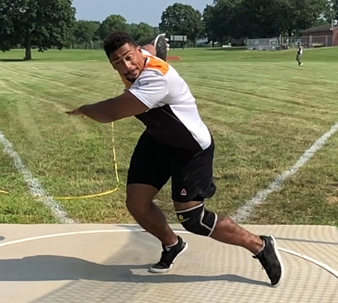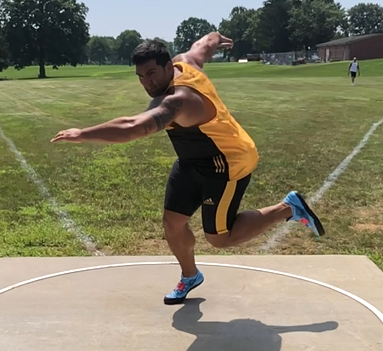Three Keys to Turn the Right Foot
- Throws University
- May 11, 2020
- 4 min read
Turning the right foot can be a difficult task, nearly impossible if it is not taught in a proper manner. This can lead to a slower rate of acceleration, poor transfer of energy, and a lackluster finish. The right foot that rotates properly in the spin can lead to a greater period of force production and ultimately a bigger throw. Fortunately, we have three key points to enable a proper right side foot position and longer throws!
Turn the Right Foot
Coaches have taught throwers for years to turn the right foot, squish the bug, extend the knee and extend the hips. For decades these drills have been used over and over again. The understanding of the right side rotation in the spin has remained at a poor level with generally a low level of biomechanics. This has led to a poor transfer of drills and thousands upon thousands of wasted drilling reps.
Throwers need the dominant side to rotate to enable vertical stiffness, to cultivate a stretch-shortening cycle and to dynamically load the hips during the middle portion of the throw. When the right side rotates effectively, weight transfers more accurately and the energy accelerates throughout the throw at an efficient and effective rate. This leads to a greater usage of rotational energy and a bigger throw. An efficient right foot will also enable a thrower to have a greater period of ground contact. When a thrower has a longer period of contact, they are able to accelerate the implement over a longer period of time!
Step #1: Comprehend Plantar Flexion
Every movement in the shot and discus should be analyzed from a global perspective. A global view of the movement can create that top-down analytical understanding. Once the global perspective is seen, technical epiphanies can occur and it can be understood where energy “leaks” occur and potentially decelerate a throw.

When a thrower grounds their right foot in the center of the circle, be it the discus or the spin or the glide, IF their dominant foot is flat, there will be a leak of energy and speed. This is akin to a point of deflation. Much like the 100-meter sprint, the stiffer the joints and muscles are the more potential energy they can reuse, and the faster that energy is utilized.

This is no different in the throws! When a thrower grounds their dominant foot in the center of the circle, a stiff ankle means a plantar flexed ankle. This vertical stiffness will then help the thrower hold a centered position while the non-dominant side rotates or moves linearly through the circle. This stiffness then aids in an effective transfer of energy at the right time to trigger big throws.

Step #2: Hold a Bent Knee

But….but…...but…..but…..what about extending our knees on the finish!?!?! Isn’t that what we are supposed to do….?!?!?
No. Extending the dominant knee will shut down the rotation, it will lead to shorter ground contact time and poor transfer of rotational energy. This can have a very negative impact on the final distance of the throw!
When the thrower grounds in the middle the ankle needs to be flexed AND the quad needs to hold knee flexion. This will lead to a greater position of HIP EXTENSION. Greater hip extension will result in a more active glute max and hamstring providing a stable point to continue on the execution of the finish.

As the right knee or dominant knee holds knee flexion and the right ankle holds plantar flexion, energy will transfer rapidly into the non-dominant leg. This rotational energy will then increase tension and transfer through the trunk and into the implement.

The Glide’s Knee...the right knee on a glider MUST still hold a bent position until the knee is just inside the sector line. Once the right knee rotates bent inside the sector, there will be a bit more extension in the glide to enable the glider to transfer forward into their heel on the toeboard. The knee bend and rotation will still happen, just a slightly different point and speed.
Step #3: Fast Non-Dominant Leg
As throwers, we love to focus on our dominant side. It’s easy to cue our dominant side and to get a quick response from the side where we hold more coordination. We often forget that some of the biggest breakthroughs in technique may happen when the non-dominant side becomes more coordinated. This is also part of viewing the throw as a full global movement!

When a thrower has a fast left leg around their right, there is a slight trigger for a stretch-shortening cycle in the abs AND there will be greater rotational energy created and then used by the dominant side. All of this transfer is set up with an effectively plantar flexed ankle and flexion of the knee joint as well. Having a rapid left side can trigger HUGE throws!
Height of the leg in the spin?
There are two models to use for foot height relative to the knee joint. The foot can either be above the knee joint or it can be in line or below the knee joint. Athletes like Gerd Kanter and Darrell Hill and Alex Rose use a higher left foot. All of these athletes have an incredibly fast left side and they all tend to hold a bent knee and plantar flexed ankle. The height of the foot almost always correlates to the initial method in how athletes were taught and this motor pattern develops consistently over time.
Throwers like Sam Mattis, Alekna, and Crouser have a low to mid-height of the left foot. The lower foot height makes the throw SLIGHTLY more rotational and potentially enables the thrower to stay grounded longer through the acceleration period at the finish.
Both leg heights are acceptable as long as the movement is rapid and the knee is flexed while the ankle is plantar flexed. The goal of a fast left leg is to create more speed for the right side to use while rotating grounded!
Recap
Rotating the right side is very important for big throws in the shot put and discus. It’s not as simple as “turn the right foot.” Instead, the right side needs to rotate through various different actions. These global actions can lead to a greater execution in an isolated joint and ultimately greater throws!

"Our aim is to provide concise and concrete education and training on the throws, helping coaches and athletes learn what they need to do to succeed and become champions."
- Dane and Trevor









